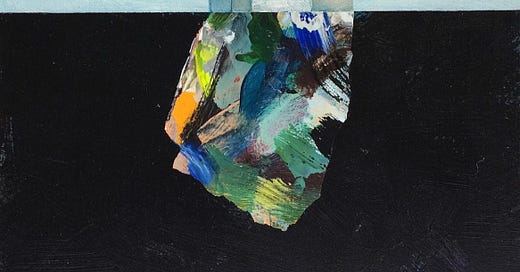One of my favorite paintings, by Annie Blake
source
from Devotions, a collection of poems by Mary Oliver
source
source
🧶 Craft Chat
These poems are all examples of the technique we’re going to play with this week —> a simple, powerful poetic structure that can be used to explore all kinds of subjects.
“Structural irony is a way of organizing a series of utterances so that what is first proclaimed is suddenly or systematically undermined by what follows.
What is undermined at the poem’s finish has been first built up to in such a way that allows the reader to become engaged in the poem's affirmations, and therefore surprised by the conclusion.” And as we’ve talked about before, surprise in poetry often equals delight. This structure allows for “complicated simplicity, which can produce poems nimble enough to juggle weighty ideas– conclusions and decisions that can be suspended in air, or playfully bobbled, decisively dropped, or laughed right off the stage.”1
The structure begins with a title or first line that declares something. It can then continue to build on the assertion, sometimes for the whole poem, before ending with lines that refute, or make us re-interpret, everything that came before. Or, they can reinterpret throughout, as the poem “Yes” does. These poems can be tiny or long, serious or playful, but follow the same basic format of “blowing a bubble, popping the bubble”.
✍️ Try it
Brainstorm a list of
► things you used to think, and have since changed your opinion on
► things you’ve heard someone say, or had advertised to you, that you don’t agree with
▶︎ a song lyric or title
► statements you’ve heard about “the way things are”
► rules you’ve obeyed or been asked to obey
► advice you’ve followed and now don’t
Pick one to try out as a title. Begin your first draft by writing at least a few sentences going along with or explaining the claim/belief of your title. Then take a few minutes to describe how or why you’ve changed or disagree, or to explore how it is more complicated than it may first appear. From this writing, build a small poem by piecing together a few sentences in an order that swivels the reader (and yourself?) towards a moment of surprise.
💌 Writing Invite #2
Set a timer for 10 minutes. Begin your free-write with the sentence “Right now, I’m ___________.” Let whatever comes, come.
“Real, solid growth and education are slow. Look at a tree. We don’t put a seed in the ground and then stick our fingers in the earth and yank up an oak. Everything has its time and is nourished and fed with the rhythms of the sun and moon, the seasons. We are no different, no more special, no less important. We belong on the earth. We grow in the same way as a rock, a snail, a porpoise, or a blade of grass.” Natalie Goldberg
“I think the aim of most poems is to erase some measure of the distance between one person and another.”
“The only way students learn how to craft their own poems is by reading and learning to pay close attention to the specific choices that other writers make. In this manner, they accumulate tools that can be put to use upon their own material.” — Tracy K Smith
As always, we’d LOVE to read what you come up with! This is a no-pressure place to share. Whatever you feel like showing us, whether a draft, your full poem, a line, some stunning poem you came across, or your experience trying out the exercises, you’re welcome to. ▼
Structure and Surprise, by Michael Theune
https://www.washingtonsquarereview.com/tracy-k-smith-interview-2018










Love the idea that “surprise in poetry often equals delight.” Looking forward to trying this!